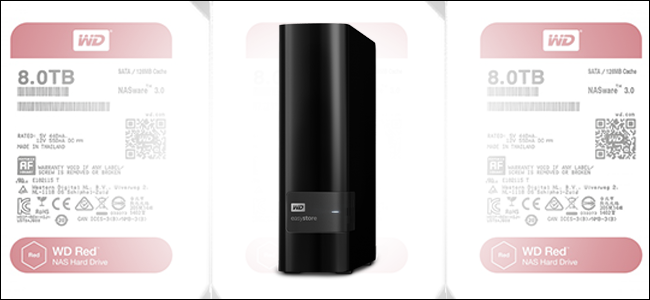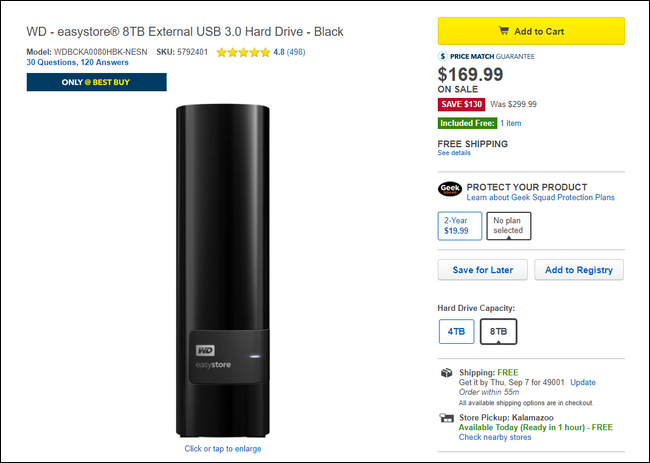Quick Links
Every now and then, you come across something that sounds way too good to be true, but against the odds, it actually works. Buying cheap external hard drives, cracking them open, and getting more expensive hard drives for your effort is one of those things.
What Is Shucking (and Why Bother)?
The original meaning of "shucking" is to remove the shuck, or outer protective layer, from food like corn and shellfish with the ultimate goal of getting to the delicious stuff inside. The process of shucking external hard drives keeps with that theme: the goal is to remove the protective plastic shell to get to the delicious high quality drive inside.
But why bother? Why strip away all the things that make the external enclosure what it is and reduce it to the bare drive? You can, after all, just buy bare drives right from the start and skip all that hassle.
Historically, it didn't make sense to bother with the effort because typically manufacturers put their lowest quality drives in external enclosures to keep costs down and profits up. All you would get for your effort, cracking into a case, was a cheap and slow consumer-grade drive.
These days, however, there is a significantly increased emphasis on external drive reliability and longevity, as many of the products on the market are meant to be left on 24/7, come with backup software, and are used much more heavily than the external drives of yesterday. To deliver on the promise of reliability and performance under such conditions, many manufactures have quietly switched to using premium drives in their external enclosures to avoid premature failure.
Here's the weird part: those external drives are sometimes less expensive than the bare version of the same drive. That means if you keep your eye on sales, you can easily score a batch of hard drives for 50% off the retail price if you're willing to get your hands dirty and shuck those drives out of their enclosures.
Let's say, for the sake of argument, you want four 8TB hard drives for a home server project. You could purchase four 8TB Western Digital Red drives for $1,160 (4 x $290), or you could buy four 8TB Western Digital EasyStore external drives on sale for $680 (4 x $170) and enjoy a savings of 58.6%.
That's like buying a whole car to get a cheap replacement engine rather than buying the engine by itself? The ecomonics are insane, but we're not complaining.
How to Select and Shuck an External Drive
You might suspect, as you rightfully should, there is more to this magical task of shucking drives than simply going down to your local big box electronics store and buying up the first (or every) external enclosure you find. You need to do your research and pick your external enclosure carefully.
Which Drives Should You Shuck?
At the moment (and throughout 2017, for that matter), the best value in drive shucking has consistently been the example we used in the previous section: the 8TB Western Digital Easystore external USB 3.0 hard drive. Practically every other week the drive is on sale at Best Buy for ~$170 and contains a Western Digital Red drive.
That may not always be the case, however, so the best thing you can do is keep an eye on discussion forums where people routinely discuss drive shucking and take on the risk of buying new enclosures and testing them (so you don't have to). The Reddit subreddit devoted to large scale home data storage, /r/DataHoarder, is a fantastic resource for drive shuckers, as the folks there are constantly searching out fresh sources of large high quality drives. You can also, when you see external enclosures on sale, search for the name of the external enclosure and "shucking" to find additional information about the drive.
The key, when doing your research, is to be as specific as possible when searching and be sure to note identifying data about particular models. Don't go shopping for general products with similar names, go shopping for specific SKU codes/model numbers---there may be small features like cache or drive speed that are different from 8TB Red drive to 8TB Red drive.
How to Shuck a Drive
Drive shucking is a really straightforward affair. Although there are differences between enclosure models on the market, the general design of modern enclosures is almost identical. The external casing is almost always held together by plastic tension tabs and the internal drive itself is always mounted to the enclosure chassis with small (often Torx-head) screws.
This means all you need to get at the hard drive inside is an appropriate screw driver and a spudger (a flat, strong, and typically plastic tool designed to help you pry apart pressure-mated electronic parts); you can purchase an actual spudger on Amazon or use tools you have on hand (like old credit cards, guitar picks, or the like). We've shucked more than a few drives in our day, and we promise the process is simple. In fact you can even look up shucking videos on YouTube for different models, like the WD Easystore, seen below, to get a feel for the process.
You'll spend more time actually buying the drives and assembling the tools you need than you will on the actual shucking process.
The Downside of Shucking
For the most part, there aren't really any significant downsides to drive shucking. At first glance, you'd assume that doing so would void your warranty, but typically opening the enclosure doesn't void the warranty, and in many cases the drive and the enclosure actually have independent warranty periods. Anecdotally, we heard many reports that the warranty period for the enclosure drive is shorter than the warranty period for a bare drive. Off the shelf Western Digital Red Drives have a 3 year warranty, for example, but the same Red drive in an external enclosure apparently has a 2 year warranty. We don't know about you, but we're completely willing to accept a 33% decrease in warranty to save more than 50% on our drive costs.
The other big downside is the simple gamble you take when playing the drive shucking game. Unlike buying a bare hard drive right off the shelf, where you know exactly what you're getting, there's no guarantee you're going to get the drive you want when you shuck an external enclosure. Even if you read a dozen forum posts, complete with picture evidence, that a particular external enclosure has a particular drive, that doesn't mean that you're going to get the same production batch, or that the company hasn't changed which drive they're using. If you've only bought a single enclosure, then perhaps it's not a big deal to just take your gambling lumps and move on, but if you've purchased a huge lot of them from an online retailer and now need to deal with the hassle and cost of returning them, the lumps are a bit more painful.
Those minor caveats aside, if you're looking for an economical way to populate a home server (and you're willing to deal with the shucking itself and, potentially, a shorter warranty) you really can't beat the price.


